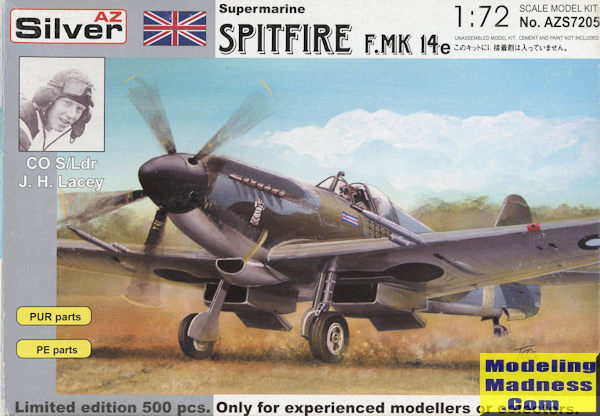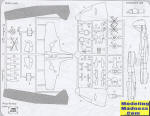
AZ Model 1/72 Spitfire F14e
| KIT #: | AZS 7205 |
| PRICE: | $ |
| DECALS: | Two options |
| REVIEWER: | Scott Van Aken |
| NOTES: | Silver series |

| HISTORY |
The first Griffon-powered Spitfires suffered from poor high altitude performance due to having only a single stage supercharged engine. By 1943, Rolls-Royce engineers had developed a new Griffon engine, the 61 series, with a two-stage supercharger. In the end it was a slightly modified engine, the 65 series, which was used in the Mk XIV. The resulting aircraft provided a substantial performance increase over the Mk IX. Although initially based on the Mk VIII airframe, common improvements made in aircraft produced later included the cut-back fuselage and tear-drop canopies, and the E-Type wing with improved armament.
Squadron Leader James Harry "Ginger" Lacey DFM & Bar (1 February 1917 – 30 May 1989) was one of the top scoring Royal Air Force fighter pilots of the Second World War and was the second highest scoring RAF fighter pilot of the Battle of Britain, behind Pilot Officer Eric Lock of No. 41 Squadron RAF. Lacey was credited with 28 enemy aircraft destroyed, five probables and nine damaged. "Ginger" Lacey was one of the few RAF pilots on operational duties on both the opening and closing day of the war. Interestingly, though he kept his wartime promotion as acting squadron leader, he was provided the permanent rank of flight lieutenant upon his retirement in 1967.
| THE KIT |
 AZ
Models has garnered quite a following over the last decade or so. They are still
what one would call a short run kit company, but not to the extent of the past
with the likes of VeeDay or Merlin. These kits are nicely detailed and molded.
However, they are not mainstream kits and need one to exercise some modeling
skills to get things to fit as well as they should.
AZ
Models has garnered quite a following over the last decade or so. They are still
what one would call a short run kit company, but not to the extent of the past
with the likes of VeeDay or Merlin. These kits are nicely detailed and molded.
However, they are not mainstream kits and need one to exercise some modeling
skills to get things to fit as well as they should.
Of course, one cannot go wrong with a Spitfire of some sort and so they produced a Spit XIVe (or F/FR.14e if post war). This kit is not the later bubble-top version, but one with the earlier canopy. The kit provides a nice interior with a fair representation of the seat, floor, front and rear bulkheads, control coloum and such. There is no seat armor, at least nothing separate, but since the back of the seat is square, perhaps it is built in. THere are also no rudder pedals. It does includes a photo etch seat harness.
This is all placed between the two fuselage halves. There is detail on the inside of the fuselage, though no positive attachment point for the interior. I'd suggest perhaps taping the fuselage halves and seeing if this could be inserted from underneath.
One has the option for standard or 'clipped' wings. To do the latter, one must clip the tips and install the replacement wing tip. There is a separate wheel well piece to fit into the lower wing. Landing gear are fair enough with two different main wheels provided. One is a four spoke version while the other has some sort of undetermined hub pattern that is very un-Spitfire like. I should mention that the box art shows three spoke wheels so perhaps these will need a replacement for accuracy. The kit offers separate oleo scissors for the main gear.
The lower wing radiators have simple blanking plates to install to prevent see-through. Guns slot into the leading edges of the wing and there is a separate carb intake for the underside. The prop has five separate blades that fit into the backing and are trapped by the spinner. There is no prop shaft so it simply glues right on the front of the cowling. The lone clear bit is a closed canopy which is fairly clear. By this time, the radio did not require a solid mast so one simply makes it from wire.
 Instructions
are quite basic but usable. There is a generic color callout and so you need to
know that 'Interior Green' is RAF Interior Green and not that used by the USAAF.
Markings are for two of Ginger Lacey's planes. One in the CBI in dark
green/ocean grey over medium sea grey. This plane has the SEAC roundels, but no
white stripes. The other is from his short time in Japan during 1946 and has
medium sea grey in place of ocean grey on the upper surfaces. This latter plane
has clipped wings and a red spinner. The decal sheet is nicely printed and
should be quite thin.
Instructions
are quite basic but usable. There is a generic color callout and so you need to
know that 'Interior Green' is RAF Interior Green and not that used by the USAAF.
Markings are for two of Ginger Lacey's planes. One in the CBI in dark
green/ocean grey over medium sea grey. This plane has the SEAC roundels, but no
white stripes. The other is from his short time in Japan during 1946 and has
medium sea grey in place of ocean grey on the upper surfaces. This latter plane
has clipped wings and a red spinner. The decal sheet is nicely printed and
should be quite thin.
| CONCLUSIONS |
This isn't the only Spitfire XIV to be done in this scale. There are kits from Fujimi and Academy as well, both of which have their detractors. I cannot vouch for the accuracy of this one, but it will certainly look the part when you are finished.
November 2016
Copyright ModelingMadness.com. All rights reserved.
If you would like your product reviewed fairly and fairly quickly, please contact the editor or see other details in the Note to Contributors.